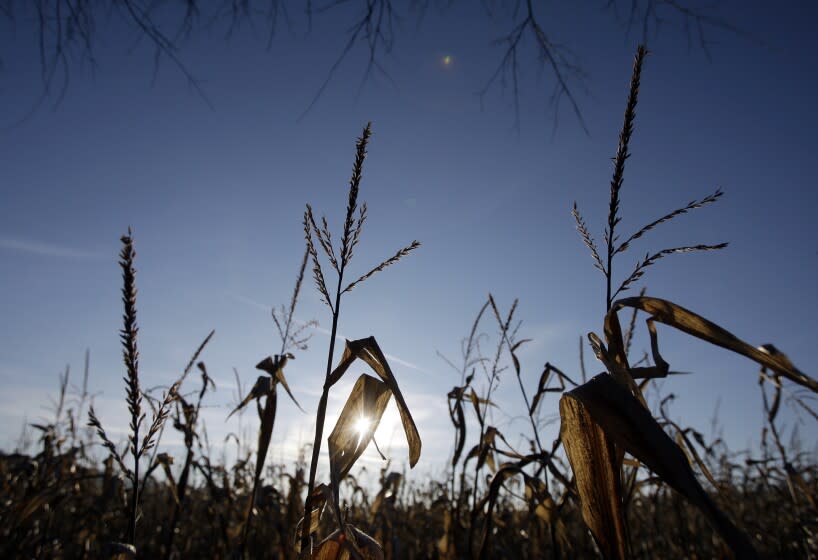Op-Ed: California wants more ethanol and carbon capture. That would lock in pollution for decades

As California prepares to update its low carbon fuel standard — a policy aiming to reduce emissions from transportation fuels — Indigenous groups and environmentalists across the Midwest are fighting one of its key provisions. The policy would incentivize ethanol production through technology that stores carbon underground not just in California, but anywhere in the U.S.
Here in Iowa, where much of the nation’s corn is raised and corn-based ethanol is produced, we are facing a corporate stampede to build thousands of miles of dangerous pipelines crisscrossing six Midwest states. This includes the development of underground toxic waste disposal sites to store carbon under Midwest lands.
California’s incentives wouldn’t deliver carbon reductions as promised. Instead, supplementing gasoline with ethanol would increase climate-damaging greenhouse gas emissions, further pollute the water from Iowa to Louisiana, and divert needed funds away from real climate solutions in California and the Midwest.
Ethanol producers say the substance generates less carbon than gasoline, but a study this year found that ethanol is 24% more carbon-intensive than traditional fuel. The enormous rise in nitrogen fertilizer to raise corn for ethanol has increased emissions of nitrous oxide, a potent greenhouse gas that is 289 times as powerful as CO2. Adding carbon capture to ethanol production will only compound these problems. Fertilizers used in corn production, including for ethanol, also cause vast water pollution extending from drinking water in Iowa to the Dead Zone in the Gulf of Mexico.
Building ethanol infrastructure locks in ethanol and gasoline for decades, reducing incentives for investors or policymakers to shift towards more sustainable transportation. In Iowa, politicians are fighting every policy and law that might move the nation toward electric vehicles or public transportation. California’s low carbon fuel policy is making their obstruction of cleaner transportation that much easier.
Carbon capture technology is aggravating climate change in other ways as well. Drilling companies pump captured CO2 underground to help extract more oil, ultimately leading to more pollution. As the Los Angeles Times reported last month, “Eleven of 12 large-scale carbon storage facilities in the United States use captured carbon dioxide for oil production.”
Such technology will require thousands of miles of CO2 pipelines across six states. Three pipeline projects are in the proposal stages in the Midwest. Sections of the proposed pipeline paths run adjacent to the existing Dakota Access pipeline, which prompted the huge Indigenous resistance at Standing Rock, N.D.
Farmers are familiar with the damage of pipeline construction because of Dakota Access. Farmers have contended with soil compaction, drainage issues and a 60 to 90% reduction in crop yields along the pipeline’s route. Studies and media reports corroborate these experiences.
Carbon capture projects need permission from landowners to build pipelines, but if farmers in Iowa refuse, developers are working with government authorities to seize the land using eminent domain. Iowans’ opposition to the pipelines is fierce and includes county government officials, farmers, Indigenous organizers, scientists and environmental activists.
CO2 pipelines also pose serious public health hazards. Rupture of a highly pressurized liquid CO2 pipeline results in an explosive release of a CO2 cloud that hugs the ground and displaces oxygen — potentially killing everything in its path and crippling internal combustion engines. This would mean that emergency responders using fossil-fuel vehicles couldn’t get to pipeline rupture victims. Mass casualties could overwhelm rural emergency health systems.
In 2020, a CO2 pipeline in Satartia, Miss., ruptured, sending 49 people to the hospital and leaving many with long-term health impacts including fatigue and lung problems. More than 250 people required evacuation. First responders needed self-contained breathing apparatuses to conduct their rescues. Residents’ cars ceased to run, and victims were found dazed or unconscious.
The highly pressurized state of liquid CO2 in pipelines, along with its corrosive nature when in contact with water, increases the risk of leaks, fractures and ruptures. In response to the Satartia CO2 pipeline rupture, the Pipeline and Hazardous Materials Safety Administration issued a report in May warning about the potential for damage to pipelines caused by earth movement and climate change, such as increased rainfall and higher temperatures. In Iowa, the pipelines are slated to be buried in farmland, where heavy farm machinery will drive over them, further increasing risks of ruptures.
Ethanol produced from corn and using carbon capture is not a climate solution. It causes a new set of problems. California’s new fuel standard should not be enabling it.
Carolyn Raffensperger is an environmental lawyer and executive director of the Science and Environmental Health Network. Sheri Deal-Tyne is a policy advocate with Physicians for Social Responsibility-Iowa.
This story originally appeared in Los Angeles Times.

